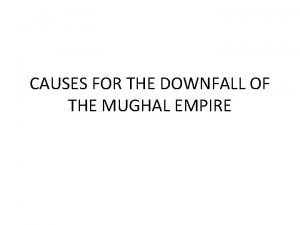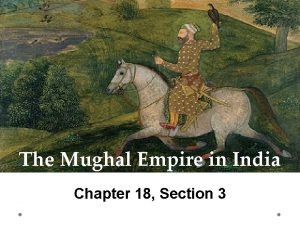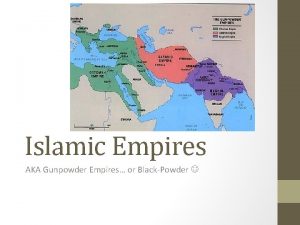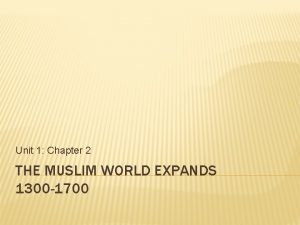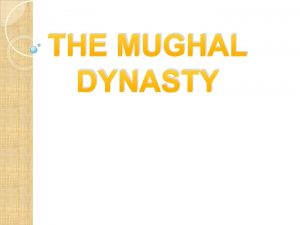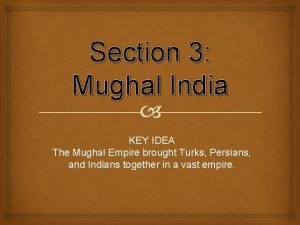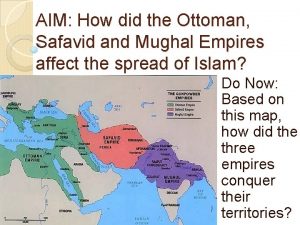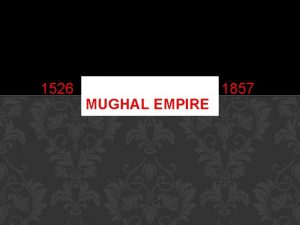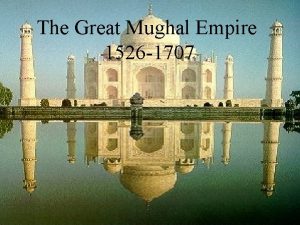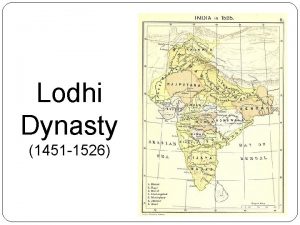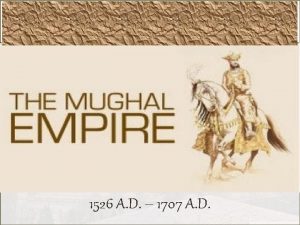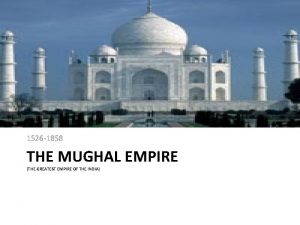MUGHAL IN S C ASIA 1526 1707 THE










- Slides: 10

MUGHAL IN S. & C. ASIA 1526 -1707

THE MUGHAL EMPIRE

MUGHAL INDIA • Babur – conquers India at the head of Turkish and Mongol invaders • Military genius and poet, claims he’s descended from Genghis Khan and Tamerlane • N. of Delhi meets a huge army led by sultan Ibrahim • Small force with cannons was victorious • “The sun had mounted spear-high when the onset began, and the battle lasted till midday, when the enemy was completely broken and routed. By the grace and mercy of Almighty God, this difficult affair was made easy to me, and that mighty army… was (Mughal is Persian for Mongol)

RELIGIOUS DIVIDE • 20% of the population was Muslim, the rest were Hindu • The ruling conquers were Muslim.

AKBAR • Attempted serious accommodation of the Hindu majority. • Brought Hindus to political/military elite. • Imposed policy of toleration • Abolished jizya • Nonmuslim tax • Created a state that stressed loyalty to the emperor. • Encouraged hybrid Indian-Persian-Turkic culture.

ECONOMICS UNDER AKBAR • Relatively peaceful time period • Conflict with other Indian Princes • Booming trade in cotton cloth with the Europeans

AKBAR’S SUCCESSORS • Jahangir • Weak son of Akbar, let his wife, Nur Jahan take care of gov’t (she was good at it) • Shah Jahan • Akbar’s grandson • Height of Mughal literature, art and architecture • His wife, Mumatz Mahal, died at 39, he cried: • “Empire has no sweetness, life itself has no relish left for me now” • He had the Taj Mahal constructed for her. • He planned a twin structure but then Aurangzeb usurped the throne and imprisoned him in 1658. He died in prison alone.

DECLINE OF MUGHAL Aurangzeb • Overzealous grandson of Akbar • Reversed stance on religious tolerance; Imposed Islamic supremacy • Banned sati, music at court and other vices • Destruction of Hindu temples. • Jizya reinstated • Enforced Islamic law • Hindu reaction: • Caused conflict within his own empire • European traders gain a foothold in India due to discontent

HOW DID MUGHAL ATTITUDES AND POLICES TOWARDS HINDUS CHANGE FROM THE TIME OF AKBAR TO THAT OF AURANGZEB?

MODEL ANSWER • Akbar recognized the fundamental reality that Hindus make up the majority of the population of the Mughal empire. He acted deliberately to accommodate the Hindus through actions like including them in the political-military majority, supporting building of Hindu temples, imposing tolerance, removing the jizya, and promoting a state cult. • Aurangzeb reversed these policies. He forbid sati, banned music at court, destroyed some Hindu temples, reinstated jizya, enforced Islamic law.
 Mughal empire
Mughal empire Yellowstone national park surveyed a random sample of 1526
Yellowstone national park surveyed a random sample of 1526 Birth of prince salim
Birth of prince salim Causes of the downfall of the mughal empire
Causes of the downfall of the mughal empire Chapter 18 section 3 the mughal empire in india
Chapter 18 section 3 the mughal empire in india Kerajaan mughal merupakan kelanjutan dari kesultanan
Kerajaan mughal merupakan kelanjutan dari kesultanan How did the ottoman safavid and mughal empires arise
How did the ottoman safavid and mughal empires arise The muslim world expands
The muslim world expands How did mughal attitudes and policies toward
How did mughal attitudes and policies toward The mughal empire in india chapter 18 section 3
The mughal empire in india chapter 18 section 3 Shiism
Shiism



